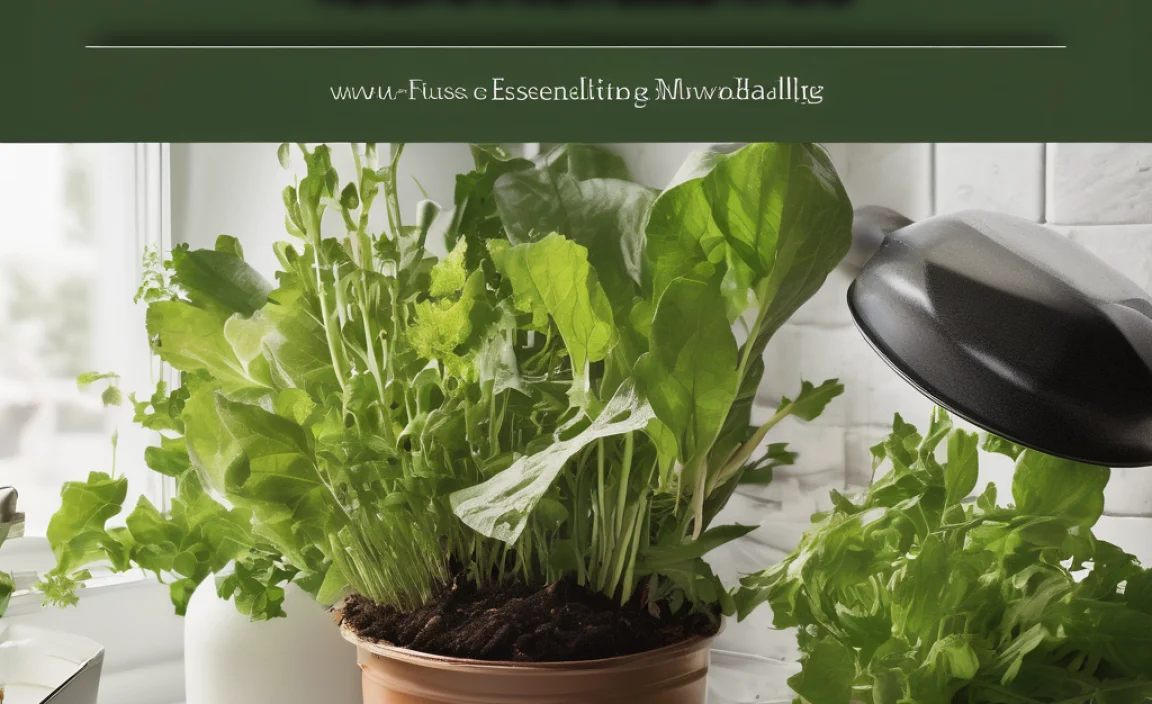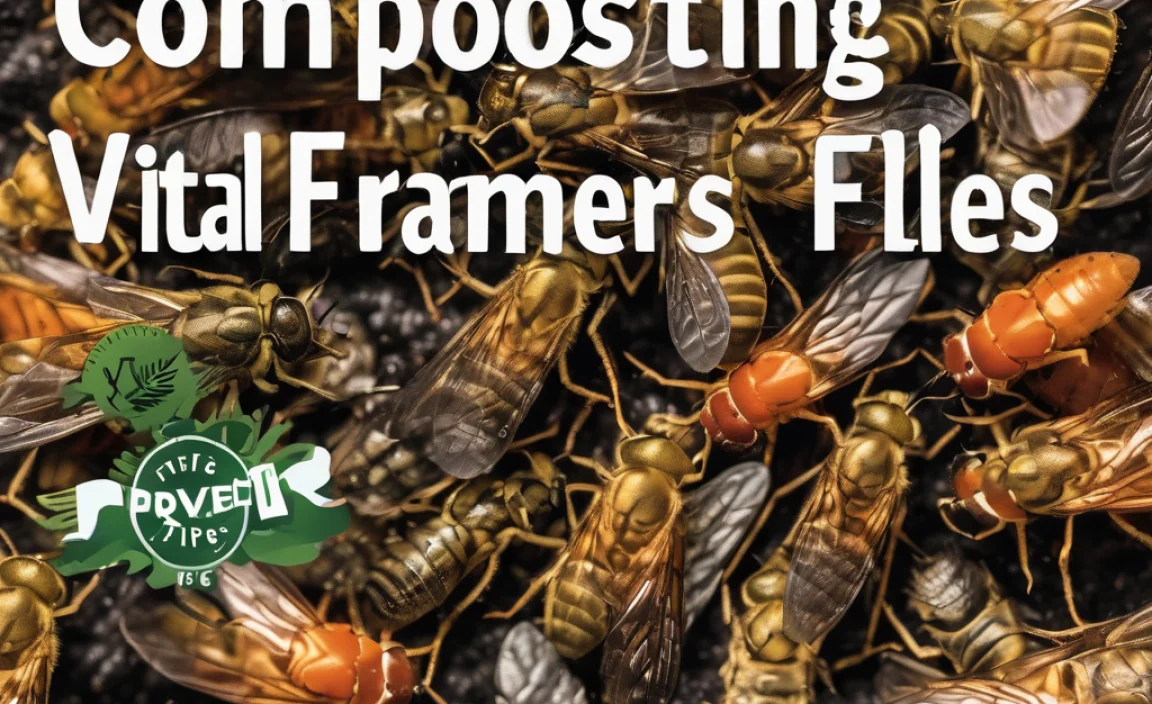Hey there, fellow garden enthusiasts! Troy D Harn here from TopChooser. If you’re diving into the wonderful world of composting, you might be bumping into a few roadblocks with your static pile. Don’t worry, it happens to everyone! Static pile composting, while simple in concept, can sometimes leave us scratching our heads when things don’t go as planned. But the good news is, most “problems” have super straightforward fixes. We’ll walk through common headaches and show you exactly how to get your compost cooking like a champ. Ready to turn those compost conundrums into compost triumphs?
Understanding Static Pile Composting
Before we tackle the hiccups, let’s briefly revisit what static pile composting is all about. Simply put, it’s a no-turn method. You build a pile of organic materials, let nature do its thing (with a little help from us!), and wait for it to transform into nutrient-rich compost. It relies on the right mix of materials, moisture, and air getting into the pile naturally. Think of it as a slow-cooker for your yard waste and kitchen scraps, rather than a pressure cooker!
Why “Static” Sometimes Means “Stuck”
The “static” part means you’re not actively turning or mixing the pile. This sounds easy, right? And it usually is! However, this lack of intervention means that if something isn’t balanced just right, the pile can get stuck in its composting process. It might smell off, take too long, or simply not break down. The key is understanding what those imbalances are and how to gently nudge them back into harmony.
Common Static Pile Composting Problems and Their Solutions
Let’s get down to the nitty-gritty. Here are some of the most frequent issues folks run into with static piles and how to fix them, Troy-style: easy peasy!
Problem 1: The Smelly Pile (Rotten Egg or Ammonia Odors)
Oh, the dreaded stink! If your compost pile smells like rotten eggs (sulfur) or strong ammonia, it’s a clear sign that things have gone anaerobic. This means there’s not enough oxygen, and the “wrong” kind of bacteria are taking over. These guys thrive in wet, oxygen-starved environments and produce those unpleasant smells.
Causes:
- The pile is too wet.
- The materials are too finely chopped, creating a dense mat that prevents airflow.
- The pile is too compacted.
- Too many “greens” (nitrogen-rich materials like grass clippings or food scraps) without enough “browns” (carbon-rich materials like dry leaves or wood chips).
Solutions:
- Aerate, Aerate, Aerate! This is your number one fix. If the smell is mild, try poking holes in the pile with a pitchfork or a sturdy stick. If the smell is strong, you might need to reluctantly turn the pile. The goal is to introduce air. You don’t have to turn it completely, just mix it up a bit to loosen it.
- Add “Browns.” If you suspect you have too many greens, add a good amount of dry, carbon-rich materials. Think shredded cardboard, dry leaves, straw, or small twigs. Mix them in as best you can. This helps absorb moisture and provides structure for better airflow.
- Check Moisture Levels. Your compost pile should feel like a wrung-out sponge – damp, but not soaking wet. If it’s too soggy, add more browns to soak up the excess water. If it’s too dry, add a little water while you’re mixing or aerating.
- Break Up Compacted Areas. Gently loosen any tightly packed sections to allow air to circulate.
Problem 2: The Pile Isn’t Heating Up (Or Cooling Down Too Fast)
Compost piles need heat to break down materials efficiently. If yours is stubbornly cool, the decomposition process will be very slow, and you won’t get that satisfying “cooking” smell or activity. This is often because something is out of balance, preventing those heat-generating microbes from doing their job.
Causes:
- The pile is too small. Microbes need a certain mass to generate and retain heat effectively. Aim for a minimum of 3x3x3 feet.
- Not enough “green” materials (nitrogen). Greens are like the fuel for the heating process.
- The pile is too dry. Moisture is essential for microbial activity.
- Too much airflow (in very dry, windy conditions) can leach heat away.
- The materials are too large. Smaller pieces break down faster.
Solutions:
- Build it Bigger! If your pile is too small, add more materials until it reaches that 3x3x3 feet minimum. It might take a little time to build it up, but it’s worth it.
- Boost the “Greens.” Add more nitrogen-rich materials like fresh grass clippings, vegetable scraps, coffee grounds, or manure. Mix them in with the existing materials.
- Add Water. Check the moisture level. If it’s dry, water it thoroughly. You can use a hose with a spray nozzle or a watering can.
- Manage Wind Exposure. If your pile is in a very windy spot, consider building a simple windbreak with pallets or tarps, or ensure it’s nestled against a building or fence.
- Chop it Up. Break down larger materials into smaller pieces. You can use a shovel, shredder, or even just your hands to chop up things like large leaves or vegetable stalks.
Problem 3: The Pile is Too Dry and Materials Aren’t Breaking Down
This one’s pretty straightforward. Microbes need water to live and work. If your compost pile is as dry as a desert, nothing will happen. You’ll just have a pile of slowly decaying stuff.
Causes:
- Lack of regular watering.
- Too many “browns” (carbon materials) that soak up moisture.
- Hot, dry weather or wind evaporating moisture.
- The pile is exposed to direct sun.
Solutions:
- Water Regularly. Make it a habit to check your pile’s moisture. If it feels dry, water it. Aim for that “damp, not dripping” consistency. You can use a hose, watering can, or even rainwater collected in a barrel.
- Mix in “Greens.” If you have a very “brown” heavy pile, adding some nitrogen-rich “greens” will help retain moisture and speed up decomposition.
- Cover Your Pile. For static piles, a light cover can be beneficial, especially in dry climates or windy areas. A tarp, a layer of straw, or even a layer of finished compost can help trap moisture. Just make sure it allows some air exchange – you don’t want to make it anaerobic. A loosely placed tarp or a layer of compostable material works well. Check out resources from the EPA on composting for more general tips on creating the right environment.
- Relocate if Necessary. If your pile is in a spot that gets relentless sun and wind, consider moving it to a partially shaded, more sheltered location.
Problem 4: The Pile is Too Wet and Soggy
We touched on this with the smelly pile, but it’s worth its own point. A soggy compost pile is a breeding ground for anaerobic bacteria, leading to foul odors and slow decomposition. It can feel like a sludge pit!
Causes:
- Adding too much very wet material (like excessive kitchen scraps or very succulent grass clippings) without enough “browns” to absorb the liquid.
- Rainwater saturating the pile, especially if it’s not covered or the cover isn’t shedding water effectively.
- The pile sits in a poorly draining spot.
Solutions:
- Add Dry “Browns.” This is your primary defense. Mix in plenty of dry carbon materials like shredded cardboard, newspaper (avoid glossy pages), straw, sawdust (use sparingly), wood chips, or dry leaves. Fluff up the pile as you add them to incorporate air.
- Turn the Pile. If it’s really saturated, turning will help expose the wet interior to air, allowing some moisture to evaporate. Forking it over onto a tarp can help.
- Improve Drainage. Ensure the base of your pile isn’t sitting in a puddle. If it is, move it to higher ground or build a base of coarse material like twigs or wood chips.
- Cover During Heavy Rain. If you anticipate prolonged heavy rain, cover your pile loosely with a tarp that allows air to circulate but sheds the majority of the water.
Problem 5: Pests (Rodents, Flies, etc.)
No one wants unwanted guests in their compost pile. While small numbers of flies or occasional visits are normal, a full-blown infestation can be a real nuisance.
Causes:
- Exposed food scraps, especially meat, dairy, or oily foods (which shouldn’t really be in a typical home compost pile anyway).
- The pile is too accessible and visible.
- The pile is too wet and attracting insects.
- Not enough material on top to cover fresh additions.
Solutions:
- Bury Your “Greens.” When you add kitchen scraps (your “greens”), always cover them with a layer of “browns” like leaves, straw, or shredded paper. This hides the attractive food smells.
- Avoid Problematic Items. Steer clear of meat, bones, dairy products, and oily foods. These are magnets for pests and can cause significant odor issues. Stick with fruit and vegetable scraps, coffee grounds, eggshells, and yard waste. For more on what to compost, check out the NC State Extension’s composting guide.
- Maintain Proper Moisture and Aeration. Pests often thrive in overly wet, anaerobic conditions. Keeping your pile properly moist and aired reduces their appeal.
- Consider a Bin. While static piles can be open piles, using a bin (even a simple one made from pallets) can make it harder for rodents to get in. Ensure there are no large gaps.
- Add Lime (Use Sparingly). A light sprinkle of lime can sometimes deter pests and help neutralize odors, but use it with caution, as too much can disrupt the composting process.
Problem 6: The Pile is Too Dense and Compacted
A dense pile is like a traffic jam for air and water. This prevents beneficial microbes from getting where they need to go and can lead to anaerobic conditions and slow decomposition.
Causes:
- Adding very fine materials without layering in coarser items.
- Over-compaction from materials piling on top of each other.
- Not enough bulky “browns” like twigs or wood chips.
Solutions:
- Layer with Bulky Materials. When building your pile, incorporate coarser items like small twigs, wood chips, or straw. These create air pockets.
- Fluff and Mix. If your pile becomes compacted, periodically fluff it up with a pitchfork or garden fork. Gently loosen any dense areas.
- Chop Larger Materials. While you want some bulk for aeration, if you have large, solid items, they can contribute to compaction if not broken down.
Troubleshooting Table
Here’s a quick reference to help you diagnose your static pile composting problems:
| Problem | Likely Cause(s) | Primary Solution(s) |
|---|---|---|
| Smelly (Rotten Eggs/Ammonia) | Anaerobic conditions (lack of oxygen), too wet, too many greens. | Aerate/turn, add browns, check moisture. |
| Not Heating Up | Pile too small, not enough greens, too dry, too many large pieces. | Build bigger pile, add greens, add water, chop materials. |
| Too Dry | Not enough watering, too many browns, hot/windy conditions. | Water regularly, add greens, cover pile. |
| Too Wet/Soggy | Too many wet greens, heavy rain, poor drainage. | Add dry browns, turn pile, improve drainage, cover from rain. |
| Pests | Exposed food scraps, inappropriate materials, accessible pile, too wet. | Bury greens, avoid meat/dairy/oils, maintain moisture/air, use a bin. |
| Dense/Compacted | Fine materials, over-compaction, lack of bulky browns. | Layer with coarse materials, fluff/mix, chop large pieces. |
Key Ingredients for Success (The C:N Ratio)
A big part of preventing problems is getting the mix right from the start. This is often talked about as the Carbon-to-Nitrogen ratio, or C:N ratio. Think of it as balancing your compost’s diet.
- “Greens” (Nitrogen-Rich): These are usually moist, often fresh materials. They provide nitrogen, which is essential for microbial growth. Examples include:
- Grass clippings
- Vegetable and fruit scraps
- Coffee grounds and tea bags
- Manure (from herbivores like cows, horses, chickens)
- “Browns” (Carbon-Rich): These are usually dry materials. They provide carbon, which is the energy source for microbes, and also create bulk for airflow. Examples include:
- Dead leaves
- Shredded newspaper and cardboard
- Straw and hay
- Wood chips and sawdust
- Twigs and small branches
The ideal C:N ratio for fast composting is around 25-30 parts carbon to 1 part nitrogen by weight. This sounds complicated, but in practice, it usually means aiming for roughly 2-3 parts “browns” to 1 part “greens” by volume when building your pile. This balance helps prevent odors, retain moisture, and keeps the microbes happy and working efficiently.
Optimizing Your Static Pile Maintenance
So, you’ve built your pile and maybe had to fix a minor issue or two. What next? Static means no turning, but it doesn’t mean “set it and forget it” entirely. A little observation goes a long way.
- Regular “Temperature” Checks (By Hand): Stick your hand into the pile (it should feel armpit-warm). If it’s cool, you might need more greens or moisture. If it’s too hot and dry, you might have too many greens or needs turning/watering.
- Moisture Monitoring: Every week or two, grab a handful of material from the inside of the pile. Squeeze it. If water drips out, it’s too wet. If it crumbles apart, it’s too dry. Adjust with browns or water as needed.
- Adding New Materials: While the pile is “aging,” you can often add new kitchen scraps and yard waste to the top or sides. Always bury fresh “greens” under a layer of “browns” to deter pests and odors.
- Observation is Key: Just look at your pile. Is it slumping? Smelling off? Mounds of dry leaves sitting on top? These are visual cues that something might need attention.
The beauty of the static pile is its simplicity. By understanding these common issues and their fixes, you can enjoy “set it and forget it” composting with minimal fuss.
When to Consider Other Composting Methods
Static pile composting is fantastic for beginners and those who want minimal effort. However, if you’re consistently facing major issues, or if you need compost very quickly, you might explore other methods:
- Turning Compost Piles: These require regular turning (weekly or bi-weekly) but break down much faster, often in a few weeks to a couple of months.
- Worm Composting (Vermicomposting): Great for smaller spaces and kitchen scraps, using specific types of worms to process food waste.
- Bokashi Composting: An anaerobic fermentation process that can handle a wider range of food scraps (including meat and dairy) but requires a specific inoculant and a different disposal step for the fermented material.
Choosing the right method depends on your space, time commitment, and how quickly you need the finished compost. But for most home gardeners, a well-managed static pile is the sweet spot!
Frequently Asked Questions About Static Pile Composting Problems

I am passionate about home engineering. I specialize in designing, installing, and maintaining heating, ventilation, and air conditioning systems. My goal is to help people stay comfortable in their homes all year long.



